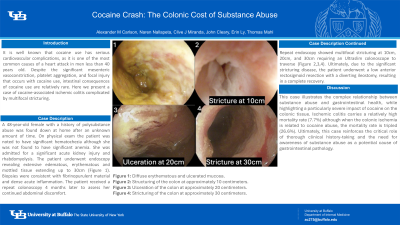Monday Poster Session
Category: Colon
P2029 - Cocaine Crash: The Colonic Cost of Substance Abuse
Monday, October 28, 2024
10:30 AM - 4:00 PM ET
Location: Exhibit Hall E

Has Audio

Alexander M. Carlson, DO
University at Buffalo
Buffalo, NY
Presenting Author(s)
Alexander M. Carlson, DO1, Naren Nallapeta, MD1, Clive J. Miranda, DO, MSc2, John Cleary, DO1, Erin Ly, MD1, Thomas Mahl, MD1
1University at Buffalo, Buffalo, NY; 2CHI Health Creighton University Medical Center, Omaha, NE
Introduction: It is well known that cocaine use has serious cardiovascular complications, as it is one of the most common causes of a heart attack in men less than 40 years old. Despite the significant mesenteric vasoconstriction, platelet aggregation, and focal injury that occurs with cocaine use, intestinal consequences of cocaine use are relatively rare. Here we present a case of cocaine-associated ischemic colitis complicated by multifocal stricturing.
Case Description/Methods: A 48-year-old female with a history of polysubstance abuse was found down at home after an unknown amount of time. On physical exam the patient was noted to have significant hematochezia although she was not found to have significant anemia. She was admitted for a significant acute kidney injury and rhabdomyolysis. The patient underwent endoscopy revealing extensive edematous, erythematous and mottled tissue extending up to 30cm (Figure 1). Biopsies were consistent with fibrinopurulent material and dense acute inflammation. The patient received a repeat colonoscopy 4 months later to assess her continued abdominal discomfort. Repeat endoscopy showed multifocal stricturing at 10cm, 20cm, and 30cm requiring an Ultraslim colonoscope to traverse. Ultimately, due to the significant stricturing disease, the patient underwent a low anterior rectosigmoid resection with a diverting ileostomy, resulting in a complete recovery.
Discussion: This case illustrates the complex relationship between substance abuse and gastrointestinal health, while highlighting a particularly severe impact of cocaine on the colonic tissue. Ischemic colitis carries a relatively high mortality rate (7.7%) although when the colonic ischemia is related to cocaine abuse, the mortality rate is tripled (26.6%). Ultimately, this case reinforces the critical role of thorough clinical history-taking and the need for awareness of substance abuse as a potential cause of gastrointestinal pathology.

Disclosures:
Alexander M. Carlson, DO1, Naren Nallapeta, MD1, Clive J. Miranda, DO, MSc2, John Cleary, DO1, Erin Ly, MD1, Thomas Mahl, MD1. P2029 - Cocaine Crash: The Colonic Cost of Substance Abuse, ACG 2024 Annual Scientific Meeting Abstracts. Philadelphia, PA: American College of Gastroenterology.
1University at Buffalo, Buffalo, NY; 2CHI Health Creighton University Medical Center, Omaha, NE
Introduction: It is well known that cocaine use has serious cardiovascular complications, as it is one of the most common causes of a heart attack in men less than 40 years old. Despite the significant mesenteric vasoconstriction, platelet aggregation, and focal injury that occurs with cocaine use, intestinal consequences of cocaine use are relatively rare. Here we present a case of cocaine-associated ischemic colitis complicated by multifocal stricturing.
Case Description/Methods: A 48-year-old female with a history of polysubstance abuse was found down at home after an unknown amount of time. On physical exam the patient was noted to have significant hematochezia although she was not found to have significant anemia. She was admitted for a significant acute kidney injury and rhabdomyolysis. The patient underwent endoscopy revealing extensive edematous, erythematous and mottled tissue extending up to 30cm (Figure 1). Biopsies were consistent with fibrinopurulent material and dense acute inflammation. The patient received a repeat colonoscopy 4 months later to assess her continued abdominal discomfort. Repeat endoscopy showed multifocal stricturing at 10cm, 20cm, and 30cm requiring an Ultraslim colonoscope to traverse. Ultimately, due to the significant stricturing disease, the patient underwent a low anterior rectosigmoid resection with a diverting ileostomy, resulting in a complete recovery.
Discussion: This case illustrates the complex relationship between substance abuse and gastrointestinal health, while highlighting a particularly severe impact of cocaine on the colonic tissue. Ischemic colitis carries a relatively high mortality rate (7.7%) although when the colonic ischemia is related to cocaine abuse, the mortality rate is tripled (26.6%). Ultimately, this case reinforces the critical role of thorough clinical history-taking and the need for awareness of substance abuse as a potential cause of gastrointestinal pathology.

Figure: Figure 1: Diffuse erythematous and ulcerated mucosa.
Figure 2: Structuring of the colon at approximately 10 centimeters.
Figure 3: Ulceration of the colon at approximately 20 centimeters.
Figure 4: Stricturing of the colon at approximately 30 centimeters.
Figure 2: Structuring of the colon at approximately 10 centimeters.
Figure 3: Ulceration of the colon at approximately 20 centimeters.
Figure 4: Stricturing of the colon at approximately 30 centimeters.
Disclosures:
Alexander Carlson indicated no relevant financial relationships.
Naren Nallapeta indicated no relevant financial relationships.
Clive Miranda indicated no relevant financial relationships.
John Cleary indicated no relevant financial relationships.
Erin Ly indicated no relevant financial relationships.
Thomas Mahl indicated no relevant financial relationships.
Alexander M. Carlson, DO1, Naren Nallapeta, MD1, Clive J. Miranda, DO, MSc2, John Cleary, DO1, Erin Ly, MD1, Thomas Mahl, MD1. P2029 - Cocaine Crash: The Colonic Cost of Substance Abuse, ACG 2024 Annual Scientific Meeting Abstracts. Philadelphia, PA: American College of Gastroenterology.
